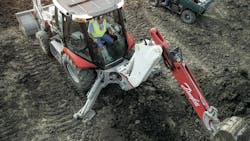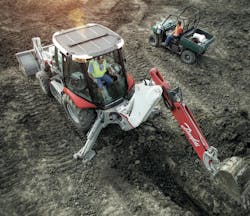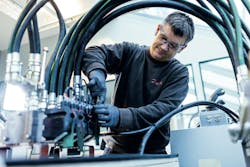Braided Hydraulic Hose Meets High Pressure Needs of Electric Backhoe
Spiral hydraulic hoses are commonly used on mobile equipment as they can manage the high pressures required by these machines. But when a major OEM was developing the next generation of its electric backhoe loader, it discovered the high-pressure fluid conveyance components it previously used did not provide the same performance.
The equipment manufacturer reached out to multiple suppliers for a hydraulic hose that would meet the 3,800 psi working pressures of its electric backhoe. In its RFQ (request for quotation), the OEM specified SAE 100R12 four-wire spiral hoses.
However, engineers at Danfoss Power Solutions saw an opportunity for the manufacturer to utilize a two-wire braided hose instead which would still meet its high-pressure requirements while offering the potential to reduce costs.
Making the Switch From Spiral to Braided Hydraulic Hoses
Traditionally, high-pressure applications have required the use of spiral hoses because they commonly have four or six layers of wire reinforcement to withstand the hydraulic pressures moving through them.
As such, the backhoe OEM specified the need for a four-wire spiral hose which would be used for the high-pressure line between the machine’s hydraulic pump and the main control valve. Although the backhoe is electric, hydraulics remain important to its functionality as many electric alternatives cannot yet match the power density needed in this type of application. Therefore, the OEM needed hydraulic hoses that could match the performance of those used in its diesel-powered machines.
During the RFQ process, Danfoss’ engineers realized there could be an opportunity to utilize the Aeroquip by Danfoss EC881 Dynamax hose. This two-braided hose has a 35% higher pressure rating than other braided hoses, suiting its use in a high-pressure hydraulic application. It is also qualified to 1 million impulse cycles, a rating that commonly requires use of a spiral construction.
These and many other features make it possible to use the EC881 hose in place of four-wire spiral hydraulic hoses in certain applications.
The Benefits of Using a Braided Hose
Utilizing a braided hose like the EC881 instead of a spiral hose can provide various cost and design benefits to OEMs.
According to Danfoss, braided hose is more flexible than spiral hose which enables the hose to be rerouted if necessary to accommodate different machine layouts. It also helps to ease installation for the OEM and maintenance for machine owners.
Spiral vs. Braided Hydraulic Hoses
Hydraulic hoses are comprised of three layers – an inner tube, a reinforcement layer, and an outer layer. For the reinforcement layer, a spiral or braided construction can be utilized.
In a braided hose, an alternating crisscross pattern of steel wires creates a braided reinforcement layer over an extruded inner tube. This design is known to be more flexible because of the interlocking pattern of the reinforcement layer which offers higher tensile strength. They are typically rated for low- to medium-pressure applications because their durability can be negatively impacted by changes in pressure.
Spiral hoses feature steel wires wrapped around an inner tube which run parallel to one another in a helical pattern. They tend to have a larger outer diameter because additional layers of opposing spiral wires are required to withstand the same pressures as braided hoses. This leads to a reduced minimum bend radius. However, they are also considered to be more durable as they can better withstand hydraulic system pressure changes.
Hose lengths can be reduced as well, which can offer both space and cost savings. This is beneficial as space within mobile equipment is becoming more limited due in part to the addition of more technologies. In some applications there is also a need for machines to have a smaller footprint – so they can fit within buildings or reduce soil compaction. As such, there is a need for hydraulic systems to become more compact which can potentially be achieved if using a braided hose.
READ MORE - A Shift Toward Compact Hydraulic Systems
Braided hydraulic hoses are also lighter in weight than spiral options, enabling overall machine weight to be reduced. This helps lower energy use and thus fuel costs for equipment owners. For electric machines, the use of batteries in place of an engine can add weight. Having the ability to reduce the weight of other systems, such as the hydraulics, can help compensate for this to ensure the machine remains the desired weight.
The electric backhoe OEM specified in its RFQ the desire for size 12 (0.75 in. inner diameter) 100R12 hoses. Danfoss was able to match this with its EC881-12 hose which also met the working pressure, burst pressure and other specifications desired by the OEM but at a lower cost.
Per Danfoss, switching to a two-wire braided hose and fittings provided a 31% cost reduction for the OEM. The reduced cost of the hose will also benefit machine owners when it comes time to change hose assemblies.
Braided Hydraulic Hose Offers Future Design Opportunities
While Danfoss knew the benefits possible with its EC881 braided hose, switching to a different hydraulic hose construction for the electric backhoe application did require some convincing.
“The mentality has been, if I want spiral performance, I need a spiral hose. And now we’re saying there’s this braided hose that can do the same. They’re skeptical,” said Scott Larson, senior engineer, Danfoss Power Solutions, in the company’s press release on the project.
Danfoss provided the OEM with an array of test data to demonstrate the hose’s ability to meet the application’s high-pressure requirements, such as how many impulse cycles the EC881 could withstand at specific pressures.
Based on what it saw in the test data as well as the OEM’s previous history with Danfoss, it decided to use the EC881 hose in its electric backhoe.
The equipment manufacturer was too far along in its design phase to change the hose performance specification and routing, but may consider doing so on future machines – especially those with space constraints – now that it knows about the flexibility possible when using the two-wire braided hose. This aspect can be taken into consideration earlier in the design process and therefore taken better advantage of if desired.
In addition, Danfoss said the OEM is looking at other applications in which it may be able to use the EC881 braided hose in place of four-wire spiral hoses.
“It's a breakthrough, in my opinion, because we've taken the industry norm of four-wire spiral hose – which is perceived as stronger and more durable – and come out with a product that still meets those requirements, but in a lower-cost hose construction,” concluded Travis DeBoer, senior account manager, Danfoss Power Solutions.
READ MORE - Extending Hydraulic Hose Life: Going Beyond Standard Expectations
Quick Facts About the EC881 Two-Wire Braided Hose
The Aeroquip by Danfoss EC881 Dynamax hose is a two-wire EN857 2SC braided hose capable of withstanding high temperatures and up to 35% higher pressure ratings. These features suit its use in agricultural, oil & gas, and mining applications, among many others.
Additional features of the braided hydraulic hose include:
- 50% better bending radius than standard hoses
- Eight times enhanced abrasion resistance with Dura-Tuff cover
- High operating temperature of 126 C (260 F)
- Durable design for long life and low maintenance costs
- Exceeds EN857 Type 1SC standard by 5X
In 2022, the EC881 was a winner of Power & Motion’s IDEA Award in the Fluid Power Category which honors the latest technology developments from various industrial engineering disciplines.
About the Author
Sara Jensen
Executive Editor, Power & Motion
Sara Jensen is executive editor of Power & Motion, directing expanded coverage into the modern fluid power space, as well as mechatronic and smart technologies. She has over 15 years of publishing experience. Prior to Power & Motion she spent 11 years with a trade publication for engineers of heavy-duty equipment, the last 3 of which were as the editor and brand lead. Over the course of her time in the B2B industry, Sara has gained an extensive knowledge of various heavy-duty equipment industries — including construction, agriculture, mining and on-road trucks —along with the systems and market trends which impact them such as fluid power and electronic motion control technologies.
You can follow Sara and Power & Motion via the following social media handles:
X (formerly Twitter): @TechnlgyEditor and @PowerMotionTech
LinkedIn: @SaraJensen and @Power&Motion
Facebook: @PowerMotionTech

Leaders relevant to this article:




